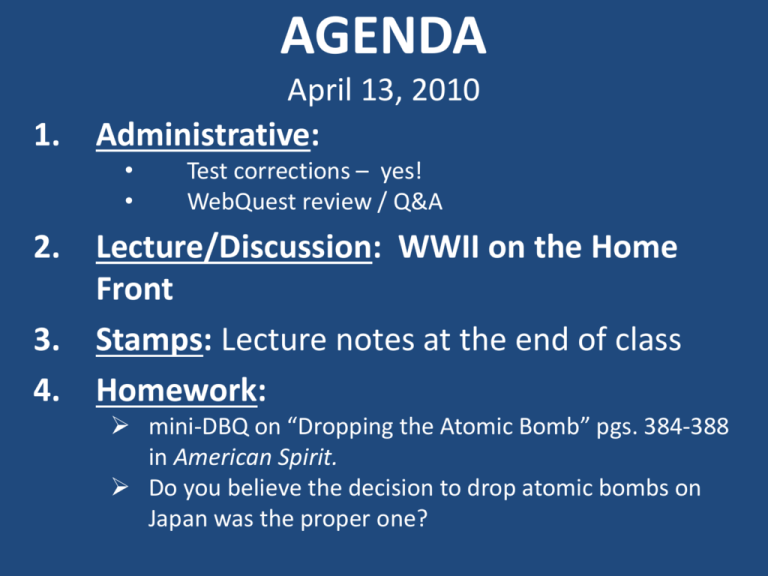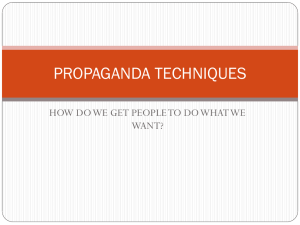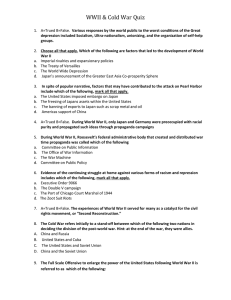
AGENDA
1.
April 13, 2010
Administrative:
•
•
Test corrections – yes!
WebQuest review / Q&A
2. Lecture/Discussion: WWII on the Home
Front
3. Stamps: Lecture notes at the end of class
4. Homework:
mini-DBQ on “Dropping the Atomic Bomb” pgs. 384-388
in American Spirit.
Do you believe the decision to drop atomic bombs on
Japan was the proper one?
“A date which
will live in
infamy…”
AUDIO
Wartime mobilization of the economy
“The arsenal of
democracy”
War Production
Board
Office of Price
Administration
War Labor Board
Who will do the work?
Rosie the Riveter
The bracero program
Urban Migration &
Demographic Changes
Copyright © Houghton Mifflin Company. All rights reserved.
Civil liberties during WWII
Executive Order No. 9066
Korematsu v. U.S.
FEPC
NAACP
Why was FDR framing the Japanese attack
the way he did?
How do you convince people to sacrifice for
the good of the nation and the war effort?
If you’re the government, how do you tell
people like Peggy Terry what the war is
about? How do you motivate them?
How do you convince U.S. citizens to lock up
110,000 of their fellow Americans?
Propaganda in WWII
Information that is spread for the purpose of promoting some
cause
wordnetweb.princeton.edu/perl/webwn
Propaganda is a form of communication aimed at influencing
the attitude of a community toward some cause or position.
en.wikipedia.org/wiki/Propaganda
Any media text whose primary purpose is to openly persuade
an audience of the validity of a particular point of view.
www.medialit.org/reading_room/article565.html
The systematic effort of controlling public opinion or a course
of action by using selected facts, ideas or allegations.
www.japanesecanadianhistory.net/glossary.htm
Propaganda Techniques
Assertion
An assertion is an
enthusiastic or energetic
statement presented as a
fact, although it is not
necessarily true. The
subject, ideally, should
simply agree to the
statement without
searching for additional
information or reasoning.
Bandwagon
Bandwagon is an appeal to the subject to follow the crowd, to
join in because others are doing so as well. Bandwagon
propaganda is, essentially, trying to convince the subject that
one side is the winning side, because more people have joined
it.
The subject is meant to
believe that since so
many people have joined,
that victory is inevitable
and defeat impossible.
Since the average person
always wants to be on the
winning side, he or she is
compelled to join in.
Card Stacking
It involves only
presenting information
that is positive to an idea
or proposal and omitting
information contrary to
it. Card stacking is used
in almost all forms of
propaganda, and is
extremely effective in
convincing the public
Glittering Generalities
Glittering generalities are
words that have different
positive meaning for
individual subjects, but are
linked to highly valued
concepts. When these
words are used, they
demand approval without
thinking, simply because
such an important concept
is involved.
Name Calling
The use of derogatory
language or words
that carry a negative
connotation when
describing an enemy.
The propaganda
attempts to arouse
prejudice among the
public by labeling the
target something that
the public dislikes.
Pinpointing the Enemy
This is an attempt to
simplify a complex
situation by presenting
one specific group or
person as the enemy.
Although there may be
other factors involved
the subject is urged to
simply view the situation
in terms of clear-cut
right and wrong.
Plain Folks
The plain folks device is
an attempt by the
propagandist to
convince the public
that his views reflect
those of the common
person and that they
are also working for the
benefit of the common
person.
Simplification
Simplification is
extremely similar to
pinpointing the enemy,
in that it often reduces
a complex situation to
a clear-cut choice
involving good and
evil. This technique is
often useful in swaying
uneducated audiences.
Testimonials
Testimonials are
quotations or
endorsements, in or
out of context, which
attempt to connect a
famous or respectable
person with a product
or item.
Transfer
It is an attempt to make the subject view a certain
item in the same way as they view another item, to
link the two in the subjects mind.
Homework
Due Wednesday/Thursday:
Mini-DBQ on “Dropping the Atomic Bomb”
pgs. 384-388 in American Spirit
Topics Wed./Thurs.:
Key events of WWII
Annotated map & timeline of WWII







